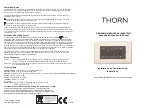
BGP Attributes
Routes learned using BGP have associated properties that are used to determine the best route to a
destination when multiple paths exist to a particular destination.
These properties are referred to as BGP attributes, and an understanding of how BGP attributes influence
route selection is required for the design of robust networks. This section describes the attributes that BGP
uses in the route selection process:
•
•
•
Multi-Exit Discriminators (MEDs)
•
•
•
NOTE:
There are no hard coded limits on the number of attributes that are supported in the BGP. Taking
into account other constraints such as the Packet Size, maximum number of attributes are supported in
BGP.
Communities
BGP communities are sets of routes with one or more common attributes. Communities are a way to assign
common attributes to multiple routes at the same time.
NOTE:
Duplicate communities are not rejected.
Best Path Selection Criteria
Paths for active routes are grouped in ascending order according to their neighboring external AS number
(BGP best path selection is deterministic by default, which means the
bgp non-deterministic-med
command is NOT applied).
The best path in each group is selected based on specific criteria. Only one “best path” is selected at a time. If
any of the criteria results in more than one path, BGP moves on to the next option in the list. For example,
two paths may have the same weights, but different local preferences. BGP sees that the Weight criteria
results in two potential “best paths” and moves to local preference to reduce the options. If a number of best
paths is determined, this selection criteria is applied to group’s best to determine the ultimate best path.
In non-deterministic mode (the
bgp non-deterministic-med
command is applied), paths are compared
in the order in which they arrive. This method can lead to Dell Networking OS choosing different best paths
from a set of paths, depending on the order in which they were received from the neighbors because MED
may or may not get compared between the adjacent paths. In deterministic mode, Dell Networking OS
compares MED between the adjacent paths within an AS group because all paths in the AS group are from the
same AS.
Border Gateway Protocol IPv4 (BGPv4)
212
Summary of Contents for S4048T
Page 1: ...Dell Configuration Guide for the S4048T ON System 9 10 0 1 ...
Page 98: ... saveenv 7 Reload the system uBoot mode reset Management 98 ...
Page 113: ...Total CFM Pkts 10303 CCM Pkts 0 LBM Pkts 0 LTM Pkts 3 LBR Pkts 0 LTR Pkts 0 802 1ag 113 ...
Page 411: ...mode transit no disable Force10 Resilient Ring Protocol FRRP 411 ...
Page 590: ...Figure 67 Inspecting the LAG Configuration Link Aggregation Control Protocol LACP 590 ...
Page 646: ...Figure 87 Configuring Interfaces for MSDP Multicast Source Discovery Protocol MSDP 646 ...
Page 647: ...Figure 88 Configuring OSPF and BGP for MSDP Multicast Source Discovery Protocol MSDP 647 ...
Page 653: ...Figure 91 MSDP Default Peer Scenario 2 Multicast Source Discovery Protocol MSDP 653 ...
Page 654: ...Figure 92 MSDP Default Peer Scenario 3 Multicast Source Discovery Protocol MSDP 654 ...
Page 955: ...Figure 119 Single and Double Tag First byte TPID Match Service Provider Bridging 955 ...
















































